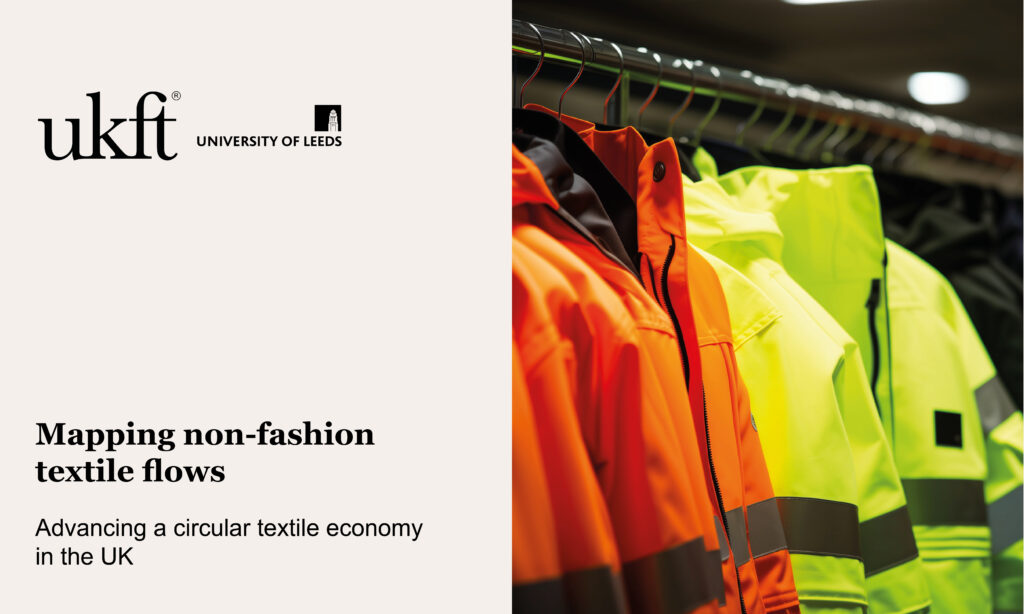Mapping non-fashion textile flows: Advancing a circular textile economy in the UK report
17/09/2025
While fashion often dominates discussions of textile waste, new research reveals that non-fashion textiles represent an equally significant, and potentially larger, portion of the UK’s textile stream. The report Mapping non-fashion textile flows: Advancing a circular textile economy in the UK, conducted by UKFT and the University of Leeds (UoL) with support from UK Research and Innovation’s Back to Baselines project, underscores the urgent need to broaden the focus of circular economy initiatives to include these overlooked materials.

Understanding the scale of non-fashion textile flows
The research mapped and quantified the primary non-fashion textile flows in the UK, drawing on extensive primary research with market experts and publicly available data from government sources. The findings are striking: the total post-consumer and industrial textile flow in the UK is approximately 3,264 kt, split roughly 50:50 between fashion (1,599 kt) and non-fashion (1,665 kt) items. This highlights a critical insight often overlooked in public discourse: non-fashion textiles (spanning healthcare, hospitality, automotive, public sector, and other commercial and industrial sectors) may exceed fashion in volume when accounting for items beyond household waste.
Key barriers to a circular non-fashion textile ecosystem
The research identifies several structural and systemic barriers preventing non-fashion textiles from entering circular pathways:
- Data gaps and lack of transparency
Reliable, consistent data on non-fashion textiles, particularly from commercial and industrial sources, is scarce. Missing information on waste composition, end markets, and redistribution channels hampers evidence-based decision-making. - Insufficient infrastructure
While fashion textiles benefit from established collection, sorting, and recycling infrastructure, non-fashion flows lack equivalent systems. Many commercial or industrial textiles are disposed of via municipal waste, resulting in incineration or landfill, and associated greenhouse gas emissions. - Limited cross-sector collaboration
Non-fashion textile flows cut across diverse industries, yet there is little knowledge exchange or coordinated action between sectors, limiting opportunities for circular solutions. - Reuse challenges
Chemical treatments, hygiene requirements, contamination, or brand-specific constraints make reuse difficult for many non-fashion items, including uniforms or cleaning textiles. - Recycling complexity
Non-fashion textiles often have complex compositions or coatings that complicate recycling processes.
Key recommendations
To overcome these barriers, the report outlines a clear pathway for advancing a circular economy for non-fashion textiles:
- Improve data collection and transparency
Establish standardised reporting frameworks across sectors and encourage public-private initiatives to track textile flows, composition and volumes. - Invest in infrastructure
Expand collection, sorting, and recycling systems to accommodate non-fashion textiles, including commercial and industrial streams, supported by innovation in reverse logistics. - Foster cross-sector collaboration
Create platforms for industries (including healthcare, automotive, hospitality, and local authorities) to co-develop circular strategies. - Prioritise recycling solutions
Recognise that reuse may be limited and invest in textile recycling technologies that can process contaminated materials, complex fibre blends, coatings, and finishes. - Support R&D and circular design
Develop recyclable or bio-based alternatives for technical textiles and embed circularity in design, finishing, and coating processes.
Adam Mansell, CEO of UKFT, said:
“This report highlights that non-fashion textiles represent a significant, and often underestimated, component of the UK’s textile waste stream. Addressing these flows is essential for achieving a truly circular textile economy. This research provides a critical evidence base for policymakers, industry and researchers to act, emphasising the need for cross-sector collaboration, infrastructure investment, and innovative solutions. Only by broadening our focus beyond fashion can the UK fully reduce the environmental impact of its textile industry and advance a sustainable, circular future.”
